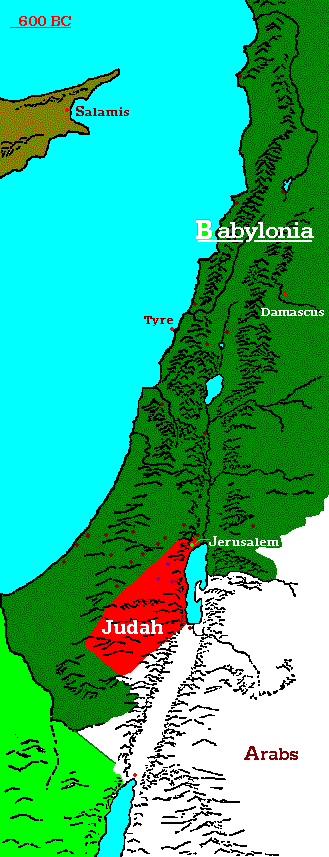Prepare Ye the Way
600 - 500 BC, the Holy Land
600 - 500 BC, the Holy Land
 The thought of subservience to yet another foreign kingdom, Babylonia, lay heavily on Judah.
Seduced by Egyptian offers of aid, King Jehoiakim ignored the desperate warnings of the Prophet Jeremeiah and refused tribute to Neduchadnezzar.
The inevitable followed: Jerusalem was taken and Jehoiakim's son, King Jehoiachin, carried into captivity in Babylon.
The thought of subservience to yet another foreign kingdom, Babylonia, lay heavily on Judah.
Seduced by Egyptian offers of aid, King Jehoiakim ignored the desperate warnings of the Prophet Jeremeiah and refused tribute to Neduchadnezzar.
The inevitable followed: Jerusalem was taken and Jehoiakim's son, King Jehoiachin, carried into captivity in Babylon.
Judah was not subdued. Egyptian ties and enticements continued. Under Zedekiah, Judah rebelled still again and this time in 586 Nebuchadnezzar destroyed Jerusalem. The tribes of Judah, Benjamin and what remained of Levi were marched away in a sad reprise of the earlier emptying of Israel. Leaders, priests and educated men were taken to Babylon and others fled into Egypt, leaving only a sparse and desolate peasantry in the land.
The Jews prospered in what turned out to be a benign captivity, retaining their separate and special identity. Their God was not confined to Jerusalem. Their prophets had taught them that their religion involved worship and morality more than the Temple and priestly sacrifice. Their religion was one of hope for the future, sustained by the prophecies of Ezekiel and Daniel.
Babylon fell to Cyrus of Persia in 539 and a new day was at hand. Persia was an enlightened overlord which distinguished between religious from political control. Cyrus allowed his well-behaved Jewish subjects to return to Jerusalem and to restore their religious center there. Many made the journey. Others remained behind, content to help support the venture. The great Diaspora, the scattering of the Jews, had begun.
The group of returnees included Zerubbabel of Davidic lineage and Jeshua, son of a previous priest of the Temple. They settled in the ruined city, built an altar, and began the arduous task of restoring the Temple itself, despite the harassment by Samaritans, the inheritors of the depopulated country. (These were the peasantry who had been left behind during the Exile and the descendants of the importees who had replaced the lost tribes of Israel.) They also had to face the ancient hostility of the Edomites who had moved into southern Judah (now called Idumaea) under pressure from the Arabs. These people resented those who, after half a century, returned to claim the land.
Finally, under Darius of Persia, the Temple was built and re-dedicated in 515 BC.
Posted by John  Read more
Read more  Comments (15)
Comments (15) ![]() 17.01.
17.01.